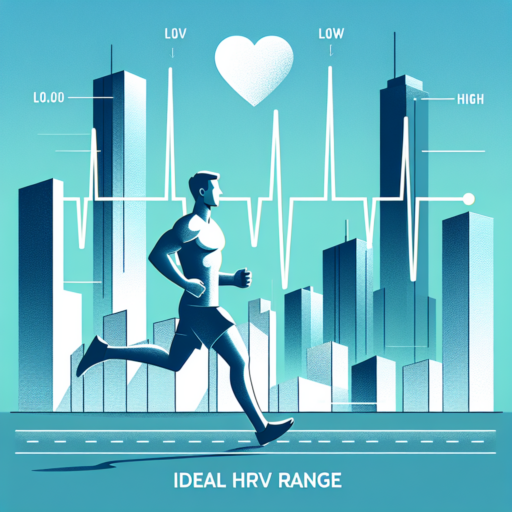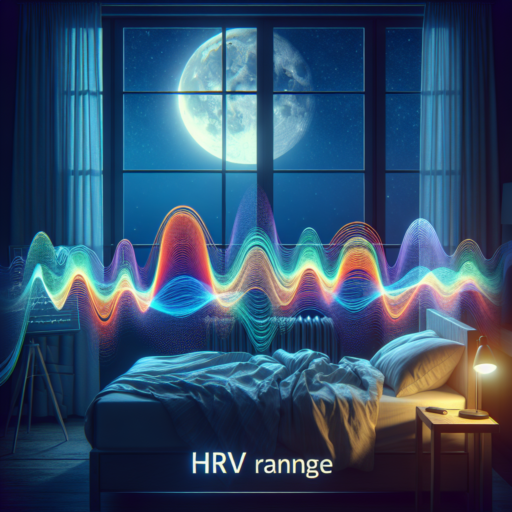What is the Ideal HRV Range for Optimal Health?
Understanding the ideal Heart Rate Variability (HRV) range is crucial for assessing your body’s ability to manage stress and maintain optimal health. HRV measures the variation in time between each heartbeat, and it’s often used as an indicator of your autonomic nervous system’s flexibility. This flexibility is vital for optimal health because it reflects your body’s ability to adapt to stress and recover from exercise, illness, and other stressors.
The ideal HRV range varies significantly among individuals, influenced by factors such as age, gender, fitness level, and overall health. Generally, a higher HRV indicates better cardiovascular fitness and a robust autonomic nervous system. It suggests your body is more capable of managing stress and recovering from it efficiently. In contrast, a lower HRV might indicate stress, fatigue, or underlying health issues. Experts suggest that for most adults, an HRV within the range of 20-100 milliseconds (ms) is considered healthy. However, it’s important to note that what’s optimal can vary widely from person to person.
Several factors can influence your HRV, including physical fitness, stress levels, lifestyle choices, and sleep quality. Regular exercise, a balanced diet, proper hydration, adequate sleep, and stress management can all contribute to maintaining or improving your HRV. Monitoring your HRV can provide valuable insights into how your lifestyle choices are affecting your body’s ability to manage stress and maintain balance. By understanding and tracking your HRV, you can make informed decisions to help optimize your health and well-being.
Understanding HRV: Importance in Tracking Health and Fitness
Heart Rate Variability (HRV) is a critical measure that reflects the variation in time between each heartbeat. It is an essential marker for assessing autonomic nervous system balance, directly linking to one’s overall health, stress levels, and fitness capabilities. By understanding HRV, individuals can gain profound insights into their physical and mental well-being, making it a crucial component for those looking to optimize their health and fitness performance.
HRV offers a unique window into the body’s response to stress, recovery, and resilience. Unlike the basic heart rate measurement, which provides a single beat-per-minute value, HRV explores the subtle beat-to-beat changes. These fluctuations are influenced by the interplay between the sympathetic (‘fight or flight’) and parasympathetic (‘rest and digest’) branches of the nervous system. This dualistic influence makes HRV a potent indicator of stress levels, recovery status, and physical fitness, offering users the opportunity to tailor their training and lifestyle for optimal health outcomes.
Key Benefits of Monitoring HRV
- Enhanced Stress Management: By keeping track of HRV scores, individuals can identify stress triggers and implement effective coping strategies ahead of time.
- Improved Recovery Times: Monitoring HRV helps in determining the body’s readiness for training, ensuring that workouts are aligned with recovery status to prevent overtraining and injuries.
- Optimized Performance: Athletes and fitness enthusiasts can use HRV data to fine-tune their training programs, maximizing performance while minimizing the risk of burnout.
Understanding and monitoring HRV is incredibly beneficial for anyone looking to improve their health and fitness. It provides actionable insights that allow for a personalized approach to health management, aligning daily activities, exercise, and rest periods with the body’s actual needs. This precision in managing one’s health and fitness strategy not only boosts overall well-being but also enhances the efficiency of achieving personal fitness goals.
Factors That Influence Your HRV Range and How to Improve It
Certainly! When focusing on HRV (Heart Rate Variability) and its significance, it’s essential to understand both the factors that can influence it and strategies for improvement.
Understanding the Impact of Lifestyle Choices
The everyday choices we make can significantly impact our HRV. Factors such as stress levels, sleep quality, and physical activity are major contributors. High levels of stress and poor sleep patterns can negatively affect your HRV, suggesting lower resilience and flexibility in dealing with stress. Conversely, regular physical activity can improve your HRV by enhancing your heart’s efficiency and resilience.
The Role of Diet and Hydration
Diet and hydration play a non-negligible role in determining your HRV range. Consuming a balanced diet rich in omega-3 fatty acids, antioxidants, and adequate hydration helps in maintaining a healthy nervous system and, by extension, a healthy HRV. Nutritional imbalances or dehydration can lead to fluctuations in HRV, indicating potential stress on the body.
Techniques to Improve HRV
Implementing certain lifestyle changes can lead to noticeable improvements in your HRV. Techniques such as mindfulness meditation, yoga, and breathing exercises are beneficial. These activities encourage a state of relaxation, reduce stress levels, and can significantly impact your HRV positively by promoting a balance between the sympathetic and parasympathetic nervous systems.
Decoding Your HRV: What Your Numbers Mean for Your Health
Understanding your Heart Rate Variability (HRV) is akin to unlocking a secret language your body uses to communicate its state of stress, recovery, and overall cardiovascular health. This critical metric, often overlooked, plays a major role in personalized fitness regimes and health monitoring. By delving into what your HRV numbers reveal, you can fine-tune your lifestyle for optimal well-being.
Your HRV score is derived from the variation in time intervals between heartbeats, with a higher variability indicating a more adaptable cardiovascular system. This adaptability is crucial for both physical and psychological health. A higher HRV has been associated with enhanced fitness levels, resilience to stress, and general well-being. Conversely, a lower HRV might signal overtraining, increased stress levels, or underlying health issues that need attention.
Interpreting your HRV can guide you to make informed decisions about your day-to-day activities and long-term health plans. For instance, noticing a consistent downward trend could be your cue to scale back on intense workouts, prioritize sleep, or address hidden stressors. Similarly, an improvement in your HRV over time can validate that your wellness strategies are effectively enhancing your body’s resilience and recovery capabilities.
How Age and Gender Affect Your Ideal HRV Range
The discussion surrounding Heart Rate Variability (HRV) and its implications on health has gained prominence in recent years. Understanding how age and gender influence your ideal HRV range becomes crucial in personalizing health strategies for improved well-being. Notably, HRV signifies the variation in time intervals between heartbeats, indicating cardiovascular flexibility and overall autonomic nervous system health. However, it’s essential to consider the physiological differences contributed by age and gender to optimize health insights.
Age-Related Changes in HRV
As individuals age, their HRV tends to decrease. This decline is partly due to the natural aging process of the cardiovascular system and the autonomic nervous system’s reduced adaptability. Younger people typically exhibit higher HRV values, reflecting robust cardiovascular health and resilience against stress. Men and women, however, experience these changes differently, emphasizing the need to adjust expectations and targets based on individual age groupings.
Gender Differences in Ideal HRV Range
Gender plays a pivotal role in determining one’s ideal HRV range. Generally, women tend to have a higher HRV compared to men when age is held constant. This difference could be attributed to hormonal fluctuations and inherent variations in heart rate dynamics between the sexes. Recognizing these distinctions is imperative for setting accurate health benchmarks and tailoring lifestyle interventions that support optimal cardiovascular function and stress management strategies.
Top Ways to Increase Your HRV for Better Physical and Mental Health
Increasing your Heart Rate Variability (HRV) is crucial for boosting both your physical and mental health. A higher HRV is associated with better cardiovascular fitness, stress resilience, and overall well-being. Here are some effective strategies to improve your HRV, thereby enhancing your life quality.
Regular Physical Exercise
Engaging in regular physical exercise is by far one of the most effective ways to boost your HRV. Activities such as walking, running, cycling, and swimming not only improve your cardiovascular health but also enhance your body’s ability to regulate its heart rate. Aim for at least 30 minutes of moderate exercise most days of the week for optimal benefits.
Mindfulness and Stress Reduction Techniques
Chronic stress negatively impacts your HRV, leading to a host of health issues. Integrating mindfulness practices like meditation, yoga, and deep-breathing exercises into your daily routine can significantly lower stress levels. These practices not only calm your mind but also help in achieving a higher HRV by promoting a state of relaxation and balance.
Quality Sleep
Never underestimate the power of a good night’s sleep when it comes to improving your HRV. Sleep plays a vital role in heart health, and disruptions in sleep patterns can lead to a lower HRV. Ensuring 7 to 9 hours of quality sleep per night can enhance your heart rate variability, leaving you feeling more rested and rejuvenated.
No se han encontrado productos.
The Role of Stress, Sleep, and Nutrition in Maintaining an Ideal HRV
Understanding the intricate relationship between stress, sleep, and nutrition is essential when it comes to maintaining an ideal Heart Rate Variability (HRV). HRV measures the time variation between heartbeats and is a critical indicator of our autonomic nervous system’s flexibility and overall cardiovascular health. The balance among these three elements—stress, sleep, and nutrition—can significantly influence our body’s physiological resilience and its ability to adapt to challenges.
Stress management is paramount in maintaining an optimal HRV. Chronic stress can lead to a decrease in HRV, signaling reduced adaptability and increased strain on the heart. Implementing stress-reduction techniques like mindfulness, meditation, or even regular physical activity can help in elevating HRV levels by fostering a parasympathetic response, also known as the «rest and digest» state, which counters the body’s stress reactions.
Quality sleep acts as a cornerstone for cardiovascular health and HRV. During sleep, the body undergoes critical recovery processes that help regulate stress hormones, repair tissues, and consolidate memory. A consistent sleep schedule and ensuring 7-9 hours of quality sleep per night can significantly improve HRV by enhancing the body’s natural rejuvenation cycles. Poor sleep habits, on the other hand, can disrupt these cycles and reduce HRV, indicating higher stress levels and reduced autonomic nervous system efficiency.
Nutrition also plays a vital role in optimizing HRV. Consuming a balanced diet rich in anti-inflammatory foods such as omega-3 fatty acids, found in fish, nuts, and seeds, along with ample fruits and vegetables, can boost HRV. Nutritional choices that support a healthy gut microbiome also contribute to reduced systemic inflammation and improved heart rate variability, making dietary habits an essential component of maintaining an ideal HRV.
How to Measure Your HRV Accurately: Tools and Tips
Measuring your Heart Rate Variability (HRV) accurately is vital for understanding your body’s response to stress, physical fitness, and overall well-being. HRV, the variation in time between each heartbeat, is a critical biometric that tells us a lot about our autonomic nervous system. With the right tools and tips, you can effectively monitor this health metric to enhance your training, recovery, and stress management techniques.
Choosing the Right Tools for HRV Measurement
To get started, you’ll need to select the appropriate tool that can measure HRV accurately. There are several types of devices available, including chest straps, wrist wearables, and even smartphone apps designed for this purpose. Chest straps are highly recommended for their precision and ability to record HRV data continuously. Wrist wearables, while convenient, may sometimes offer slightly less accuracy but are continually improving. Smartphone apps, when used with a compatible heart rate monitor, can also provide valuable insights into your HRV trends over time.
Tips for Accurate HRV Measurement
When measuring your HRV, consistency is key. For the most reliable readings, it’s best to take your measurements at the same time each day, ideally in the morning right after waking up. This helps in minimizing the variables that could affect your HRV. Ensure you’re in a rested state, both physically and mentally, avoiding any form of exercise or caffeine intake at least 30 minutes before taking your measurement. Moreover, your position during the measurement can affect accuracy; lying down or sitting in a comfortable position is recommended.
Understanding your HRV readings can offer powerful insights into your health and fitness journey. With the right tools and consistent, accurate measurements, you can leverage this data to make informed decisions about your training, recovery, and stress management strategies. By paying attention to daily, weekly, and monthly trends, you can detect changes in your overall well-being and adapt your practices accordingly.
Interpreting HRV Data: A Guide to Optimize Your Training and Recovery
Understanding and interpreting Heart Rate Variability (HRV) data is a pivotal aspect of optimizing your training and enhancing your recovery periods. HRV, a measure of the variation in time between each heartbeat, is a critical biomarker for assessing physical fitness, stress levels, and overall cardiovascular health. This guide aims to illuminate the importance of HRV data in tailoring your workout regimes and recovery strategies for optimal performance.
Deciphering HRV Scores: One of the first steps in interpreting HRV data is understanding what your scores mean. An improved or higher HRV score often indicates a robust and responsive cardiovascular system, suggesting that your body is well-recovered and ready for training. Conversely, lower HRV scores can signal overtraining, stress, or the need for more rest. Recognizing these patterns allows you to adjust your training load and recovery methods to better suit your body’s current state.
Optimal Training Insights: Analyzing your HRV data provides invaluable insights into how your body responds to certain training volumes and intensities. By observing trends over time, you can identify which types of workouts contribute to improvements in your HRV and, consequentially, your overall fitness. This empowers athletes to make data-driven decisions about when to push harder and when to dial back, striking a delicate balance between achieving peak performance and avoiding burnout.
Comparison of HRV Ranges: Athletes vs. Non-Athletes
Heart Rate Variability (HRV) is increasingly recognized as a crucial metric for assessing cardiovascular health, athletic performance, and overall well-being. The HRV ranges for athletes compared to non-athletes highlight fascinating differences, rooted in the varying demands placed on their bodies and their training’s impact on cardiovascular efficiency. Understanding these differences is key for both groups to optimize health and performance outcomes.
Distinguishing HRV Patterns
Athletes typically exhibit higher HRV scores due to their enhanced cardiovascular system efficiency, primarily a result of consistent physical training. This higher HRV indicates a more resilient heart, capable of adjusting quickly to stressors, a vital trait for peak performance. In contrast, non-athletes might have lower HRV scores, reflecting less flexibility in heart rate adjustment and potentially highlighting an increased cardiovascular risk or lower stress resilience.
Impact of Training Intensity
The nature and intensity of physical activity also play a crucial role in influencing HRV ranges. For athletes, engaging in a mix of aerobic and anaerobic training tends to optimize HRV, contributing to better cardiovascular health and recovery capabilities. Non-athletes, however, who might lead a sedentary lifestyle or engage in sporadic physical activities, often display narrower HRV ranges, suggesting a different set of cardiovascular and autonomic responses to daily stressors.
It’s important to recognize that individual variability significantly influences HRV rates, meaning that there are outliers in both groups. Nevertheless, the general patterns observed between athletes and non-athletes offer valuable insights for tailoring fitness and health strategies to individual needs and capacities.




